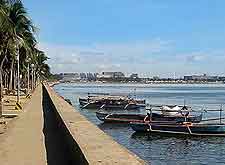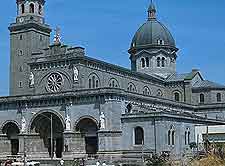Manila History Facts and Timeline
(Manila, National Capital Region, Philippines)

The most densely populated metropolis on the planet, Manila is the capital of the Philippines archipelago and the greater city area is home to some 20 million residents.
Set on Manila Bay, the sprawling city began in its present form as a number of residential suburbs based around the walled Spanish Jesuit settlement of Intramuros, originally built to keep out pirates and rebellious tribes during the Spanish colonisation of the region.
Early History
The history of settlement in Manila's region goes back roughly one thousand years, to the Tondo peoples' occupation of the land. By the late 15th century, the town was a fortified Muslim trading hub built on the remains of many previous towns and ruled by the Brunei Sultanate. For a short time in the 14th century, the sparsely inhabited area became a province of the Hindu Indonesian Majapahit Empire.
The several different dynasties that ruled the region made it easier for Spanish colonists to employ a 'divide and conquer' strategy after their arrival. Earliest records suggest that the name of the area might have come from a local dialect, with 'may nila' meaning 'there is a nila tree over there'.
Spanish Colonisation
The great Portuguese explorer and mariner, Ferdinand Magellan, was the first European to set foot on the islands in the early 16th century, and it took the Spanish Empire another 50 years or so to arrive in force and face off the city's Muslim defenders. Led by Miguel Lopez de Legaspi (Legazpi), the Spanish conquered the region at the 1571 battle of Bangkusay Channel (Bankusay), using muskets and cannons against arrows and spears.
Legaspi claimed the islands for the Spanish Empire, thus beginning over 300 years of colonisation and ultimately establishing Manila as the administrative centre. Further armed troops in the region put down local resistance and Jesuit missionaries roamed the countryside, converting the native population to Roman Catholicism.
The Philippines became an outpost of the Mexico Colony of Spain, named after King Philip II of Spain. Manila grew as an important maritime trade centre for Chinese porcelain and other goods being shipped across the Pacific to Mexico and onwards to Europe.

The 19th Century
Aside from a brief attempt by the Chinese to take over the colony, an even briefer attempt by the Dutch, and two years under British rule, Manila's history saw it develop as a colonial trading hub over the years. However, by the beginning of the 19th century, all Spain's colonies were in disarray due to corrupt administration, opening opportunities for educated Filipino patriots intent on revolution.
In the final years of Spanish rule, the country's present national hero emerged, challenging colonial rule with his political writings. José Rizal (José Protacio Rizal Mercado y Alonso Realonda) was an educated Filipino who was put on trial and executed in 1896 for his part in the revolutionary Katipunan movement. Today his name is found throughout the city and country, including a park and museum within the city's historical core of Intramuros.
By the year of 1898, Spain was at war with America and, after a heavy defeat at the Battle of Manila Bay during that year, relinquished her colony to the Americans.
The Early 20th Century and WWII
American colonisation introduced the English language, a reform of the educational system, Western culture and various democratic processes, as well as modern roads, bridges and architectural styles. Manila expanded in every direction and the USA government committed to independence for the island nation within ten years of 1935. In its early 20th-century years, the Philippines was the toast of South-East Asia, known as the 'Pearl of the Orient', although these days that is perhaps something of a stretch of anyone's imagination.
Unfortunately, WWII intervened in 1939, with Manila in the centre of the Asian theatre of war after the bombing of Pearl Harbour by the Japanese. In 1942, the Japanese occupation began, lasting until early 1945, and causing the city to fall victim to almost total destruction by Allied bombing raids (only
Warsaw suffered worse bombing). A day trip to the island of Corregidor is a good reminder of the fortifications surviving from this period. The city was finally liberated when General 'I shall return' McArthur landed in Leyte and pushed the Japanese out of the archipelago.
Finally, in 1946 the Philippines gained its long-awaited independence as a nation, ushering in a new period of history in Manila and across the entire Philippines. However, like many newly independent nations, the country soon fell into the hands of an infamous dictator, in this instance Ferdinand Emmanuel Edralin Marcos, who ruled with an iron fist from Manila for some 21 years, until a popular uprising sent him and his shoe-loving wife Imelda packing in 1986.
Today, Manila is a somewhat schizophrenic city, comprising gargantuan shopping malls, visible slums and the restored Intramuros district. This is the sole remaining historic quarter of the city, with most other buildings not surviving the earthquakes and hurricanes the periodically hit the city.
 The most densely populated metropolis on the planet, Manila is the capital of the Philippines archipelago and the greater city area is home to some 20 million residents.
The most densely populated metropolis on the planet, Manila is the capital of the Philippines archipelago and the greater city area is home to some 20 million residents.